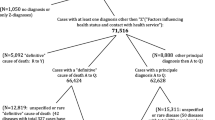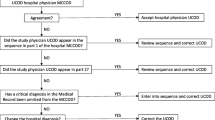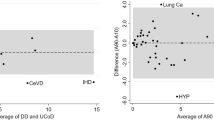Abstract
Biases can distort, limit or inhibit the value of mortality data as an epidemiological resource. From 9500 deaths occurring in Naples␣(Italy) during 1994, a random sample of 372 death certificates reporting ill-defined causes and multiple causes of death was extracted. The code for the underlying cause on the death certificate (assigned code) was compared with the cause reattributed with the aid of interview of the certifying physician or clinical records (modified code). The aim was to investigate the extent of misclassification of ‘underlying cause’ in deaths attributed to ill-defined and/or multiple causes and the shortcomings in the ICD-IX. Ill-defined underlying causes of death (7.0% of death certificates) were cardiovascular diseases, tumours with no specified site or nature, symptoms, signs, ill-defined conditions and senility. There was disagreement between the initially assigned code and the modified code in 53.8% of ill-defined underlying causes; discordance was high for the certificates filled in by the family physician. Multiple causes of death were observed in 23.6% of certificates; of these 59.2% concerned subjects aged 75 years and over at death. Diabetes was always listed in association with other pathologies but neoplasms and traumas were generally listed alone. Disagreement between codes occurred in 48 (54.5%) certificates indicating multiple causes. In 10 of them, death was established as due to a concurrence of causes. As regards ill-defined causes of death, the authors concluded that specific training on certifying procedures would be insufficient on their own; the physician should be made aware that certification is a fundamental requirement for building up epidemiological data. Evidence-based educational interventions are needed. As regards multiple causes of death, multicausal analysis may be indicated for deaths due to a concurrence of causes.
Similar content being viewed by others
References
Burnett CA, Silverman DT, Lalich NR. A comparison of analyses of occupational bladder cancer: Death certificate vs. population-based case-control interview data. Am J Ind Med 1994; 25: 677–688.
Nuttens MC, Salomez JL, Tillard B, Richard JL, Pons E, Huart J, Bocquet P. Validity of death certificates in the study of ischemic heart diseases. Press Med 1990; 19: 1143–1146.
Pan BJ, Hong YJ, Chang GC, Wang MT, Cinkotai FF, Ko YC. Excess cancer mortality among children and adolescents in residential districts polluted by petrochemical manifacturing plants in Taiwan. J Toxicol Environ Health 1994; 43: 117–129.
Brzezinski J Zbigniew. Mortality indicators and health for all strategies in the WHO European region. World Health Statistics Quarterly 1986; 39: 365–378.
Hanzlick R. Death certificates. The need for further guidance. Am J Forensic Med Pathol 1993; 14: 249–252.
Jordan JM, Bass MJ. Errors in death certificate completion in a teaching hospital. Clin Invest Med 1993; 16: 249–255.
Nielsen GP, Bjornsson J, Jonasson JG. The accuracy of death certificates. Implications for health statistics. Virchows Arch A Pathol Anat Histopathol 1991; 419: 143–146.
Percy C, Stanek E, Gloeckler L. Accuracy of cancer death certificates and its effect on cancer mortality statistics. Am J Public Health 1981; 71: 242–250.
Berghams L, Lagasse R, Gruppo di lavoro italiano per lo studio della qualità della certificazione e codifica. Lo studio della qualità della certificazione e codifica delle cause di morte nei paesi della comunità europea (CEE). Atti del V Convegno Nazionale sugli studi di mortalità. Firenze, 24–26 october 1990.
Cameron HM, McGoogan E. A prospective study of 1152 hospital autopsies: I. Inaccuracies in death certification. J Path 1981; 133: 273–283.
Carvalho ML, Silver LD. Reliability of the certification of the basic causes of neonatal deaths: Implications for the study of preventable mortality. Rev Saude Publica 1995; 29: 342–348.
Coultas DB, Hughes MP. Accuracy of mortality data for interstitial lung diseases in New Mexico, USA. Thorax 1996; 51: 717–720.
Engel LW, Strauchen JA, Chiazze L, Heid M. Accuracy of death certification in an autopsied population with specific attention to malignant neoplasm and vascular diseases. Am J Epidemiol 1980; 11: 99–112.
Gideon NM, Mannino DM. Sarcoidosis mortality in the United States 1979–1991: An analysis of multiple cause mortality data. Am J Med 1996; 100: 423–427.
Iwatsubo Y, Pairon JC, Archambault de Beaune C, Chamming's S, Bignon J, Brochard P. Pleural mesothelioma: A descriptive analysis based on a case-control study and mortality data in Ile de France, 1987–1990. Am J Ind Med 1994; 26: 77–88.
Maudsley G, Williams EM. 'Inaccuracy’ in death certification. Where are we now? J Public Health Med 1996; 18: 59–66.
Messite J, Stellman SD. Accuracy of death certificate completion: The need for formalized physician training. JAMA 1996; 275: 794–796.
MMWR. Sensitivity of death certificate data for monitoring diabetes mortality. Diabetic eye disease follow-up study, 1985–1990. Morb Mortal Wkly Rep 1991; 40: 739–741.
Perola M, Vuori E, Penttila A. Abuse of alcohol in sudden out-of-hospital deaths in Finland. Alcohol Clin Exp Res 1994; 18: 255–260.
Ribak J, Lilis R, Suzuki Y, Penner L, Selikoff IJ. Death certificate categorization of malignant pleural and peritoneal mesothelioma in a cohort of asbestos insulation workers. J Soc Occup Med 1991; 41: 137–139.
Rizzi DA. Causes of death in patients with cerebral neoplasm. Ugeskr Laeger 1991; 153: 2000–2003.
Smyth ET, Wright SC, Evans AE, Sinnamon DG, MacMahon J. Death from airways obstruction: Accuracy of certification in Northern Ireland. Thorax 1996; 51: 293–297.
ISTAT. Classificazione delle malattie, traumatismi e cause di morte, IX Revisione. Roma, 1975.
Balzi D, Barchielli A, Geddes M, Stefanini P, Vannucchi G. Manuale per la raccolta codifica ed elaborazione dei dati di mortalità. CISM Firenze 1989; 93–113.
Hsia DC. Accuracy of Medicare reimbursement for cardiac arrest. JAMA 1990; 264: 59–62.
Cornejo E, Kirschbaum A, Castillo P. Ill-defined causes of death in the elderly. Rev Med Chil 1990; 118: 92–98.
Van der Merwe S, Yach D, Metcalf CA. Peering into the black hole. The quality of black mortality data in Port Elizabeth and the rest of South Africa. S Afr Med J 1991; 79: 419–422.
Barchielli A, Geddes M. Le cause di morte non adeguatamente definite nelle statistiche di mortalità italiane. L'Igiene Moderna 1984; 81: 1075–1091.
Kohn RR. Cause of death in very old people. JAMA 1982; 247: 2793–2797.
Lindahl BI, Johansson LA. Multiple cause of death data as tool for detecting artificial trends in the underlying cause statistics: A methodological study. Scand J Soc Med 1994; 22: 145–158.
Steenland K, Nowlin S, Ryan B, Adams S. Use of multiple-cause mortality data in epidemiologic analyses: US rate and proportion files developed by the National Instute for Occupational Safety and Health and the National Cancer Institute. Am J Epidemiol 1992; 136: 855–862.
Israel RA, Rosenberg HM, Curtin LR. Analytical potential for multiple cause of death data. Am J Epidemiol 1986; 124: 161–179.
Beer V, Schick MT, Minder CE. Mortality analysis: when is single evaluation of the basic cause of death allowable, when should multi-causality be assessed? Soz Praventivmed 1990; 35: 17–23.
Jougla E, Papoz L, Balkau B, Maguin P, Hatton F. Death certificate coding practices related to diabetes in European countries. The ‘EURODIAB Subarea C’ Study. Int J Epidemiol 1992; 21: 343–351.
Mackenbach JP, Snels IA, Friden-Kill LM. Diabetes mellitus as cause of death. Ned Tijdschr Geneeskd 1991; 135: 1492–1496
EPIINFO. Public domain software for epidemiology and diseases surveillance (CDC-WHO). Version 6.
Evans PM, Alberman E. Certified cause of death in children and adults with cerebral palsy. Arch Dis Child 1991; 66: 325–329.
Jimenez-Cruz A, Leyva-Pacheco R, Bacardi-Gascon M. Errors in the certification of death from cancer and the limitations for interpreting the site of origin. Salud Publica Mex 1993; 35: 487–493.
Moussa MA, Shafie MZ, Khogali MM, el Sayed AM, Sugathan TN, Cherian G, Abdel-Khalik AZ, Garada MT, Verma D. Reliability of death certificate diagnoses. J Clin Epidemiol 1990; 43: 1285–1295.
Chou P, Chou YJ, Lai MY. Mortality trends in the past 20 years in Pu-Li, Taiwan. Chung Hua I Tsa Hsueh Chih Taipei 1992; 50: 29–36.
Garcia Benavides F, Godoy C, Perez S, Bolumar F. Multiple codification of the causes of death: From dying ‘of’ to dying ‘from'. Gac Sanit 1992; 6: 53–57.
Jougla E, Papoz L, Balkau B, Simon D, Vauzelle-Kervroedan F, Hatton F. Analysis of diabetes-related mortality in France (1970–1987) from multiple causes of death. Diabete Metab 1991; 17: 337–345.
Author information
Authors and Affiliations
Rights and permissions
About this article
Cite this article
D'Amico, M., Agozzino, E., Biagino, A. et al. Ill-defined and multiple causes on death certificates – A study of misclassification in mortality statistics. Eur J Epidemiol 15, 141–148 (1999). https://doi.org/10.1023/A:1007570405888
Issue Date:
DOI: https://doi.org/10.1023/A:1007570405888




